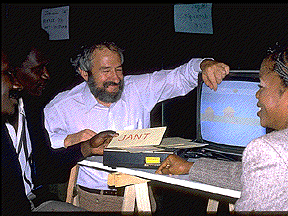Remembering Le Centre Mondial L’Informatique ^
- A few pictures taken while working at The World Center for Computers and Human Development, 22 rue Matignon, Paris.
- The Eiffel Tower (7th)

- Paris in the spring — with stunning engineering structures too !
The World Center For Computers and Human Development was an initiative begun in 1982 under the aegis of newly elected French President Francois Mitterand. The founding President was Jean-Jacques Servan-Schreiber. The Administrative Director was Nicholas Negroponte. Seymour Papert was Scientific Director.
- The World Center, 22 rue Matignon (8th)

- In the heart of the 8th arrondisement, off the Champs Elysee, this building at 22 avenue Matignon was the home of “Le Centre” for the ten years of its existence. Like many others from MIT, I was affiliated with Le Centre Mondial only in its initial years.
- XEW, the Village Microworld (Senegal Project)

- One of the first projects of Le Centre Mondial looked to introducing computers in Senegalese schools. Mamadou Niang, Moussa Gning, and Mme. Fatimata Sylla joined me in creating a prototype microworld using their traditional language, Wolof, for that effort. The work was reported in an article appearing in the UNESCO Courier, Computers and Literacy in Traditional Languages.
- Using the XEW microworld

- In the XEW mircroworld, Logo interprets one word at a time. JANT creates a picture of the SUN. ASAMAAN puts it in the sky. NIT is a word for person. What might AWYONG mean in Wolof?
- Editing the Shape FAS of the XEW microworld

- When I suggested, as gently as I could, that the shape of FAS did not look much like a “horse.” my colleague Mamadou taught me a lesson we all need. “I’m sure the children will do better.”
- A Demo for the Chief Scientist of The World Center

- Mamadou holds the card with the Wolof word JANT, explaining the rationale of the project to Centre Scientific Director, Seymour Papert. Moussa is farther from the computer, as is Mme. Sylla.
Epitaph for Le Centre Mondial
(from Paul Tate in Datamation).
The Center intended to use microcomputers to take computing to
the people through educational workshops in both the developed and
the developing world. Field projects were set up in France and
Senegal, and research schemes were introduced covering interactive
media, systems architecture, AI, user interfaces, and medical
applications. It was to be an international research center
independent of all commercial, political, and national interests.
Naturally, it failed. Nothing is that independent, especially an
organization backed by a socialist government and staffed by highly
individualistic industry visionaries from around the world. Besides,
altruism has a credibility problem in an industry that thrives on
intense commercial competition. By the end of the Center’s first year,
Papert had quit, so had American experts Nicholas Negroponte and
Bob Lawler. It had become a battlefield, scarred by clashes of
management style, personality, and political conviction. It never
really recovered. The new French government has done the Center a
favor in closing it down. But somewhere in that mess was an
admirable attempt to take high technology, quickly and effectively,
along the inevitable path into the hands of the public. The Center
had hoped to do that in different countries. . . . The Center is unlikely
to be missed by many. Yet, for all its problems, it made a brave
attempt to prepare for some of the technical and market realities of
the next few years. We regret that such a noble venture met with
such an ignoble end.
The Center intended to use microcomputers to take computing to
the people through educational workshops in both the developed and
the developing world. Field projects were set up in France and
Senegal, and research schemes were introduced covering interactive
media, systems architecture, AI, user interfaces, and medical
applications. It was to be an international research center
independent of all commercial, political, and national interests.
Naturally, it failed. Nothing is that independent, especially an
organization backed by a socialist government and staffed by highly
individualistic industry visionaries from around the world. Besides,
altruism has a credibility problem in an industry that thrives on
intense commercial competition. By the end of the Center’s first year,
Papert had quit, so had American experts Nicholas Negroponte and
Bob Lawler. It had become a battlefield, scarred by clashes of
management style, personality, and political conviction. It never
really recovered. The new French government has done the Center a
favor in closing it down. But somewhere in that mess was an
admirable attempt to take high technology, quickly and effectively,
along the inevitable path into the hands of the public. The Center
had hoped to do that in different countries. . . . The Center is unlikely
to be missed by many. Yet, for all its problems, it made a brave
attempt to prepare for some of the technical and market realities of
the next few years. We regret that such a noble venture met with
such an ignoble end.
